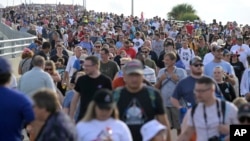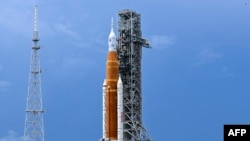U.S. space agency, NASA, postponed the planned launch Monday of a new rocket and crew capsule designed to eventually send astronauts back to the moon after encountering a series of fueling leaks and difficulties in getting one of the booster engines chilled to the correct temperature for liftoff.
If it resolves the problems, NASA could attempt the launch again on Friday.
“We don’t launch until it’s right,” NASA administrator Bill Nelson said of the postponement. “You can’t go. There are certain guidelines, and I think this is illustrative that this is a very complicated machine, a very complicated system, and all those things have to work.
“And you don’t want to light the candle until it’s ready to go,” Nelson said. “They’ll get [the problems] fixed, and then we’ll fly.”
NASA engineers were unable to chill one of the rocket booster’s engines to the correct temperature, a process that involves running liquid hydrogen kept at minus 217 degrees Celsius through the engines. Engineers tried several fixes, but none worked.
NASA teams earlier on Monday dealt with delays due to a thunderstorm that passed near the launch site in the southeastern state of Florida, as well as a leak discovered during fueling operations.
The test involves the Space Launch System rocket, the most powerful in NASA’s history, which will propel the Orion capsule without any astronauts on board for this flight. Orion is due to go around the moon and return to Earth, with the entire journey taking about six weeks.
If successful, NASA plans to fly astronauts around the moon in 2024 and potentially put them on the lunar surface as early as 2025.
The launch is part of NASA’s Artemis program, which aims to have humans walk on the moon for the first time since 1972, including the first woman and person of color to do so.
NASA is also planning a moon base as part of Artemis and said it will use what it learns to inform efforts to send the first astronauts to Mars.
Some information for this story came from The Associated Press, Agence France-Presse and Reuters







